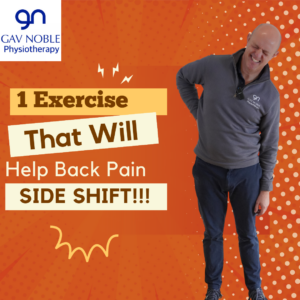One Powerful Exercise to Correct a Side Shift in Back Pain

Oh, the human back. A marvel of engineering, it supports our every move, holds us upright, and yet, when it acts up, it can bring us to our knees. Among the myriad back problems many of us Brits experience, a ‘side shift’ is one of the less discussed yet fairly common issues. Today, I’m diving deep into this topic to arm you with a simple exercise that could be a game-changer.
Understanding the Side Shift
Imagine for a moment that you’re looking at someone’s back, and you notice their upper body is leaning or shifted to one side. It’s as though they’re standing in a breeze that’s persistently pushing them off-centre. That, dear reader, is a visual representation of a side shift. Often accompanied by discomfort or pain, it’s more than just a postural hiccup.
A side shift can occur due to a number of reasons – an awkward movement, lifting something incorrectly, or even from prolonged poor posture. The spine, which should ideally be in the middle of our back, shifts to one side, resulting in the visible lean and often causing a sharp, localised pain.
The Magic Bullet: The Side Shift Correction Exercise
Though the term ‘magic bullet’ might sound fanciful, with persistent practice, the following exercise can be just that for many. Ready to give it a go? Here’s a step-by-step breakdown:
1. Wall Support: Stand sideways next to a wall, with the side you’re leaning away from closest to the wall. Your feet should be around 30 cm away from the wall for balance.
2. Elbow Push: Lift the elbow of the arm closest to the wall and place it against the wall at shoulder height. Your forearm should be perpendicular to your body, pointing forwards.
3. Lean In: Gently and slowly lean your hip into the wall. This should bring a stretch on the opposite side and a slight compression feeling on the side closest to the wall. This movement encourages the spine to shift back to its central position.
4. Maintain and Repeat: Hold this position for 5 seconds and repeat 10 times. As you continue with the repetitions, you may find it becomes easier to get your hip closer to the wall as the spine starts to correct itself.
5. Frequency: Aim to perform this exercise twice daily, especially if you’re experiencing significant discomfort.
Important Notes:
– If you feel any sharp pain or if the discomfort increases, stop immediately.
– This exercise is not a replacement for professional medical advice. Always consult a healthcare professional, like a physiotherapist, before trying any new exercise.
Benefits Beyond the Shift
While the primary goal of this exercise is to correct the side shift, it brings along a basket of other benefits. Regular practice can:
1. Improve Overall Posture: A corrected side shift means a better alignment of the spine, leading to improved posture.
2. Decrease Pain: As your spine aligns, the uneven stress distribution across your back muscles and joints is corrected, often reducing pain.
3. Increase Mobility: A more aligned spine and relaxed back muscles can increase the range of motion and overall flexibility.
4. Boost Confidence: Standing tall and straight can boost confidence levels. After all, posture isn’t just physical, it’s psychological too.
The Road to a Happier Back
The journey of a thousand miles starts with one step, or in this case, one lean against a wall. Though this exercise may seem simple, its consistent application could be transformative for many suffering from a side shift. Think of it as sending your spine a gentle nudge, coaxing it back to where it should be.
Back issues can be complex, and the side shift is just one of many possible concerns. Always remember, it’s essential to listen to your body and consult with professionals when in doubt. As the old British saying goes, “Prevention is better than cure”. So, give that wall a nudge and your back the love it so rightly deserves. Safe journeying on the road to recovery!
Check out the exercise being done by clicking HERE!